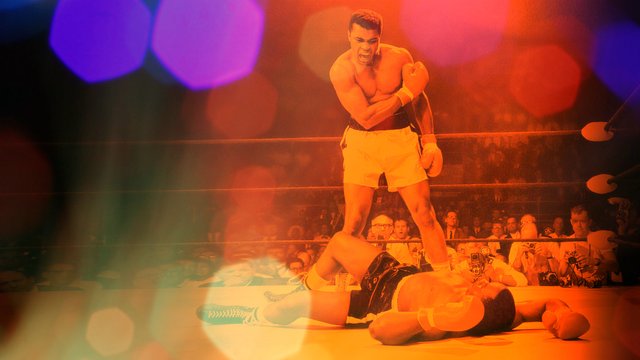"Arise And Shine Like Muhammad Ali" - Visionary Artist Spotlight

Cassius Clay, a.k.a. Muhammad Ali
Muhammad Ali is one of only three boxers to be named “Sportsman of the Year” by Sports Illustrated. He has appeared on the cover of Sports Illustrated magazine on 37 different occasions, second only to Michael Jordan. He is regarded as one of the best pound-for-pound boxers in history.
Being Beneath the Dirt
Poor grades were probably the reason for his withdrawal from high school, and even though he re-enrolled, he graduated at the lowest 4% of his graduating class. He later failed the U.S. Armed Forces qualifying test because his writing and spelling skills were sub par. His battles continued when he refused his draft induction into the U.S. Army, while America was at war with Vietnam. When an all-white jury found him guilty of draft evasion, Ali was imprisoned, his boxing license was revoked, and he was stripped of his world championship.
Branching Out Roots for Balance
Ali had a highly unorthodox style for a heavyweight boxer. Rather than the normal style of carrying the hands high to defend the face, he instead relied on foot speed and quickness to avoid punches and carried his hands low. Ali made a name for himself with great hand speed, as well as fast feet and taunting tactics. He was a masterful self-promoter, and his psychological tactics before, during, and after fights became legendary. As an amateur boxer, Cassius Clay (Ali’s given name) won two national Golden Gloves titles and the Light Heavyweight gold medal in the 1960 Summer Olympics. Ali’s record was 100 wins with 5 losses when he ended his amateur career.
Rising like a Surfacing Stem

Cassius Clay upset Sonny Liston to win the World Heavyweight Championship on February 25, 1964
When he achieved his first championship, defeating the “invincible” Sonny Liston, in 1964, Ali revealed that he was the member of the Nation of Islam. He discarded his surname, Cassius Clay, as other Nation members did, as a symbol of his ancestors’ enslavement. Malcom X announced that clay would be granted his “X,” and on the same night, Elijah Muhammad issued a statement that Clay would be renamed Muhammad (one who is worthy of praise) Ali (forth rightly guided caliph). Joining the Nation of Islam made him one of that era’s most recognizable and controversial figures.
Muhammad Ali’s fight against induction into the U.S. Army inspired hatred among many, but also admiration among some. Support for Ali grew during the 5-year court battle. During his years without a boxing license, Ali supported himself by opening a restaurant chain called Champburger. He also visited colleges, giving speeches across the country. Joe Frazier, who had become champion during Ali’s absence from the ring, often gave financial assistance to Ali during this time. The U.S. Supreme Court overturned his conviction by a unanimous decision, deciding that under the tenets of Islam Ali was a conscientious objector, not a criminal.
“Champions aren’t made in the gyms. Champions are made from something they have deep inside them – a desire, a dream, a vision.”
Reaching Fruition
As a professional boxer, Ali was 18-0 before meeting beating Liston to become the heavyweight champ, and he successfully defended his title nine times over the course of less than 2 years. He lost his boxing license during what was likely the peak of his career, and after regaining his eligibility, he lost his first bout to Joe Frazier. In a 1974 rematch, Ali knocked out Frazier. He went on to KO George Foreman to win his second heavyweight championship. In 1978, he lost the title to Leon Spinks, and at 36, it was widely believed that Ali’s fighting career was over. However, seven months later, Ali regained the title from Spinks by knockout.
While Ali was renowned for his fast, sharp out-fighting style, he also had a great chin, and displayed a great heart and ability to take a punch, as evidenced in his 1974 fight against George Forman in Zaire, called Rumble in the Jungle. Ali outlasted Forman by retreating to the ropes, inviting Foreman to hit him. Ali’s tactic of leaning on the ropes, covering up, and absorbing ineffective body shots was later termed “The Rope-A-Dope.” By the end of the seventh round, Foreman was exhausted. In the eighth round, Ali dropped Foreman by KO.
Leaving a Legacy
In 1984, Ali discovered he had Parkinson’s disease, a neurological syndrome characterized by tremors, rigidity of muscles and slowness of speech and movement. Despite the disability, he remained a beloved and active public figure throughout his lifetime. After his retirement from boxing, Ali devoted himself to humanitarian endeavors around the globe. He was a devout Muslim, and traveled the world over, lending his name and presence to hunger and poverty relief, supporting education efforts of all kinds, promoting adoption, and encouraging people to respect and better understand one another.
I upvoted You
Upvoted